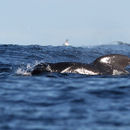Diagnostic Description
provided by FAO species catalogs
Externally, the long-finned pilot whale resembles its short-finned relative. The head is globose, with an upsloping mouthline. The flippers are extremely long (18 to 27% of the body length) and slender, with pointed tips and an angled leading edge that forms an "elbow". The dorsal fin is about one-third of the way back from the snout tip, and is low, widebased, and falcate. The tail stock is deepened (remains of more-or-less uniform height from the saddle patch to just ahead of the flukes). Males have a larger, more bulbous head; larger, thicker dorsal fin; and deeper tail stock than do females. Predominantly dark brownish grey to black, pilot whales have a white to light grey anchor-shaped patch on the chest, a light grey "saddle" behind the dorsal fin, and light grey "eyebrow" streaks. Inside the mouth are 8 to 13 pairs of sharp, pointed teeth in the anterior part of each jaw. Can be confused with: In some temperate waters, long-finned and short-finned pilot whales overlap in distribution. In these areas, the 2 species will be extremely difficult to distinguish at sea. Tooth counts and relative flipper lengths (both of which are generally not useful in at sea sightings) are helpful means of separating the 2. In the lower latitude areas of its range, the long-finned pilot whale can be confused with false killer whale and less likely, pygmy killer whale and melon-headed whale; however, the differences in head shape and dorsal-fin shape and position should permit correct identification.
- bibliographic citation
- Marine mammals of the world. Jefferson, T.A., S. Leatherwood & M.A. Webber - 1993. FAO species identification guide. Rome, FAO. 320 p. 587 figs. .
- author
- Food and Agriculture Organization of the UN
Size
provided by FAO species catalogs
Newborns are 1.7 to 1.8 m long. Adults reach 6.7 m (males) and 5.7 m (females) in length. Bulls reach weights of 2 000 kg.
- bibliographic citation
- Marine mammals of the world. Jefferson, T.A., S. Leatherwood & M.A. Webber - 1993. FAO species identification guide. Rome, FAO. 320 p. 587 figs. .
- author
- Food and Agriculture Organization of the UN
Brief Summary
provided by FAO species catalogs
Pilot whales are highly social; they are generally found in pods of about 20 to 100, but some groups contain more, to over 1 000. Based on photo-identification and genetic work, pilot whales appear to live in relatively stable pods like those of killer whales, and not in fluid groups characteristic of many smaller dolphins. The mating system is hypothesized to be polygynous, which is consistent with the observed sexual dimorphism and adult sex ratio. Pilot whales are apparently deep divers. Groups often forage in broad ranks, sometimes with other species. Although they sometimes are aerially active, pilot whales are often seen rafting in groups at the surface, apparently resting. This is one of the species most often involved in mass strandings. Strandings are fairly frequent, for instance, on Cape Cod (Massachusetts, USA) beaches from October to January. Their tight social structure also makes pilot whales vulnerable to herding, and this has been taken advantage of by whalers in drive fisheries off Newfoundland, the Faeroe Islands, and elsewhere. Breeding can apparently occur at any time of the year, but peaks occur in summer in both hemispheres. Mating occurs primarily in spring to summer. Primarily squid eaters, pilot whales will also take small medium-sized fish, when available.
- bibliographic citation
- Marine mammals of the world. Jefferson, T.A., S. Leatherwood & M.A. Webber - 1993. FAO species identification guide. Rome, FAO. 320 p. 587 figs. .
- author
- Food and Agriculture Organization of the UN
Benefits
provided by FAO species catalogs
The major exploitation of this species is probably the drive fisheries that were mentioned above. Today they are only taken in Greenland and the Faeroe Islands, but in the past, Newfoundland, Norway, Iceland, Shetland, Orkney, and the Hebrides were also sites of fisheries. Pilot whales are also known to be taken incidentally in trawl and gillnets fisheries in the western North Atlantic, and in swordfish driftnets in the Mediterranean. IUCN: Insufficiently known.
- bibliographic citation
- Marine mammals of the world. Jefferson, T.A., S. Leatherwood & M.A. Webber - 1993. FAO species identification guide. Rome, FAO. 320 p. 587 figs. .
- author
- Food and Agriculture Organization of the UN

